Five summers ago, we moved into a house that is fronted by 250 feet of blank chain link fence. I saw a grape canvas. And I started planting.
Now in 2018 I see that my vision had been a good one. We’ve got 13 vines growing and a few dozen feet of fence left uncovered. Chain link is an ideal support for grapevines.
And at this point I feel I’ve learned enough about how to best plant them, train them, and prune them that it’s time to share.
To keep this post focused, I won’t say much about growing grapes generally. I’ll direct you to this excellent page of resources all about growing grapes made by the Master Gardeners of Sacramento County. And may I also direct you to an excellent slide presentation on growing grapes in a California backyard made by Chuck Ingels, the editor of the highly recommended book, The Home Orchard?
Planting
So here’s what I do. Plant the vines about six inches from the fence and not too close to the footing of a fence post, where you’ll run into its clump of concrete. And plant each vine at least eight feet apart; mine are at exactly eight.
Training: first summer
The first year, let everything grow. No pruning. The canes and leaves that grow make energy (photosynthesize) for the roots, and the main goal in the first year is to get the plant big and established.
But sometime in the spring or early summer (if your grapevine is happy in its new home), you will have a couple feet of fresh, new green growth. Find the one cane that is strongest — thickest and longest — and tie it up the fence, straight up. I use the green tape that is sometimes called nursery tape. Tie every foot or so.
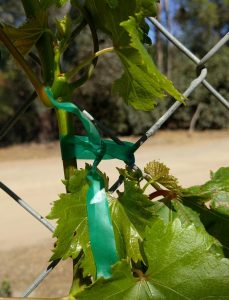
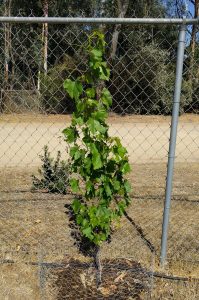
Don’t let the canes weave in and out of the fence. Just tie them to one side of the fence. These canes are going to grow thicker over time, and if you’ve allowed them to weave in and out of the fence, there’s no going back. They’ll consume the fence and you’ll never be able to prune them out entirely. You’ll have to damage the fence or leave bits of cane on the fence. If only tied to one side of the fence, however, you can decide to remove the vine at any time and do so completely, leaving no damage to the fence.
Also, as you tie the cane up, don’t tie the very end of the cane; put your last tie about a foot from the cane’s end. Sometimes tying down the end of the cane seems to stifle its continued growth. Finally, don’t wait too long to start tying the strong cane up or else it will get stiff and attach to the fence in an undesirable way and be more difficult to place vertically, as you want.
Or as I want, I should say. What if you just let a grapevine grow on a chain link fence without this tying, training, and later, pruning? It will grow, and it will give you grapes, but it will also take over your world. Grapes can be incredibly vigorous plants. Training and pruning them as I’m describing ensures that the vines stay within a certain size and produce the near-maximum in quantity and quality of fruit.
Back to training: Once the strong, vertically tied cane reaches the top of the fence, bend it to the right or left and begin tying it horizontally. Whichever way you direct it, another cane will grow near the bend that you can use to tie horizontally in the other direction. What we’re aiming for is a “T” shape. This might be as far as your vine gets in the first year.
Training: second summer
My chain link fence is 5.5 feet tall, and I have my top horizontal arms at that height. But I’ve also grown lower horizontal arms on all of my vines at 3.5-4 feet from the ground. Having two sets of horizontal arms allows for two levels of foliage as well as two levels of fruit production — although not necessarily more overall fruit production.
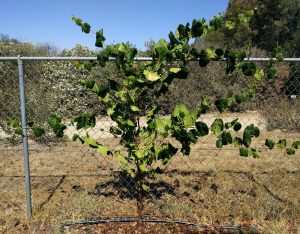
Sprouts will grow off the sides of your vertical trunk in the second spring if they hadn’t in the first spring, so if you want lower arms just choose two and tie them horizontally.
After you’ve got the two or four horizontal arms that you want, your training work is done. This is the scaffold that the vine will have for the rest of its life.
A note on nomenclature: I’m using the word “arm,” but grape people usually use the fancy word “cordon” for these permanent arms.
Pruning
Each winter, you’ll have to cut off a lot of the past summer’s growth. Don’t be timid about this. Remember that grapes are incredibly vigorous plants. Also, don’t be haphazard. You need to prune in specific ways or you may not get any fruit the next year.
I cut my horizontal arms back to three feet in length, every winter. Then, on each arm, I cut off all but four canes, every winter. I choose four that are growing strongly and are spaced at least a fist’s distance apart.

Then I cut each of the four canes on each horizontal arm back to two nodes (buds where a cane will grow), every winter. These stubs of two nodes are called “spurs,” and this method of pruning is called “spur pruning.” It works well on most grape varieties.
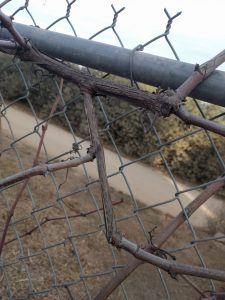
Here is what each of my vines looks like in January after pruning is finished.
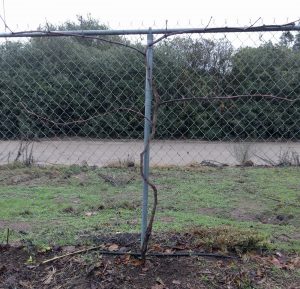
Totalling things up, each grapevine will have about 16 spurs (four on each arm, and four arms). If you have a vine with only two arms, you’ll also want to prune down to a total of about 16 spurs, so maybe eight on each arm. Much more and the grapevine may not have the energy to make them all productive. Much fewer and you’ll get less fruit than is possible.
The following spring, all of the nodes on the spurs that were left will begin to grow and it is on them that clusters of grapes form in the summer.
Repeat the above pruning every winter, indefinitely.
Your grapevines will repeat their provision of wonderful clusters of grape berries for you every summer, indefinitely.
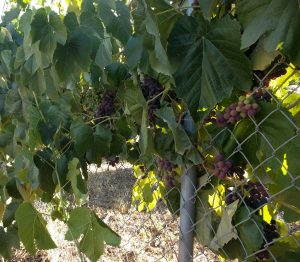

End note: A few grape varieties need to be “cane pruned.” This means that instead of cutting back the canes on each arm to two nodes, you leave them longer, about 15 nodes long. Be sure to look up how your specific variety needs to be pruned.
You might also like to read my posts:

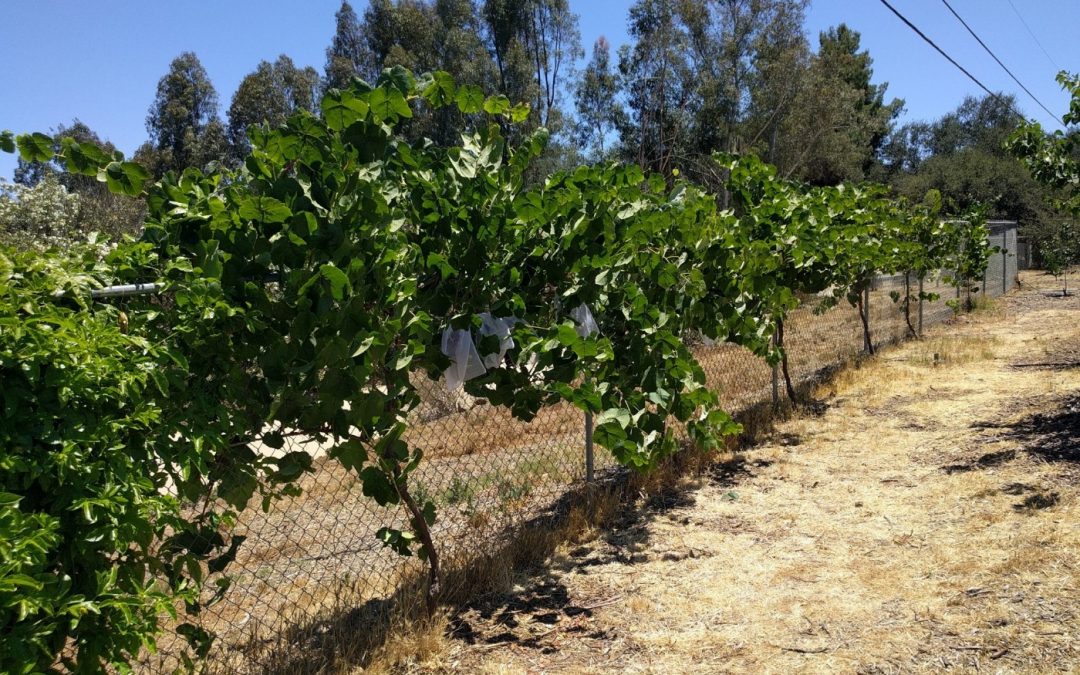


Hi!
I have black chain-link fence that’s seperates us from a highway. I like black chain-link looks-wise but why not add more privacy and grapes! I found your info and I liked it 🙂 any advice on how to begin the planting process for a beginner.. from seeds? Also do you recommend planting at the post or can it be anywhere? Thx
Hi Ludita,
Go for it! I love the grapes on my fence; I’m eating so many here in mid-summer.
The easiest time to plant new grapevines is in the middle of winter. If you can find a nursery that sells bare-root grapevines, then buy some there in winter. These have always grown very well for me, and they’re easy to start because winter weather is mild and here in California the soil is moist from rain.
I plant mine near the posts sometimes but never too close to the concrete footings. I think the closest I’ve planted to the posts is about eight inches away. The vine can be fastened to the rest of the fence no problem; you don’t need to plant near a post.
Perfect timing for finding this article. Loved it and found it very helpful.
My first year growing grapes. I just planted a concord grape plant at my chain link fence today. This is going to be fun!
Happy Vineyards!
So do the grape canes on the top of the fence grow downward naturally or do you end up tieing all the canes down?
Great information. Easy to understand and love the pictures. Thank you!! I just bought my self a little piece of land and I am planing to plant grapes along the fence.
I am in East San Diego County. What varieties of grapes do you recommend for eating?
On a side note: I just came a crossed your blog this morning and have been immersed for the last few hours. I have a note pad next to me writing all your helpful bits. Thank you so much for taking your time to write. I love how thorough your posts are! I am a subscriber here to stay! Can’t wait o complete me acre and a half food forest.
Hi Lacey,
Thank you! As I’m in Ramona, the grape varieties that do well in my yard are likely to do well in yours although I have heard from some people in East San Diego County not far from me who deal with powdery mildew more than me. No two yards are the same, but . . .
I like all of the varieties that I have on my chain link fence. They are Venus, Blueberry, Flame, and Princess. If I had to rank the purple ones, I’d put Venus at the bottom and Blueberry and Flame above. Blueberry gets a very rich flavor while Flame gets very sweet even as it retains a surprising crispness.
Princess is a light green color (yellowish really), and only produced this year for the first time but we all liked it. The season was a bit later than the other varieties, but I don’t know if that will change as the vine matures.
Greg: We live in Del Rio, Tx, a small town on the Mexican boeder 140 miles directly west of San Antonio. Texas A&M, and. numerous other sites, recommend Champanel as a variety that will grow well in our clay based soils. I have zero experience with grapes. Have you any experience with this variety, do you recommend them, and which method should be used when pruning them? They will be planted on a chain link fence that runs north to south, and is in full sun. I am really enjoying your site, and am going to bookmark it when I get home from walking.
Hi Curt,
Thanks. I have no experience with that variety, but I do see that L.E. Cooke has information about it and I’ve always found L.E. Cooke reliable. They say that Champanel should be cane pruned: https://www.lecooke.com/Images/Grapes/Champanel(CMYK).pdf
I have revisited this page a million times, but every year I get overwhelmed and distracted by other things that my yard needs. 🙁 So my question is this. How would you alter those instructions in my case, where I have a shorter chain link fence between three and a half and 4 ft tall and the vines have been growing for several years?
I’m absolutely willing to cut them to the ground and start over.
Thank you so much.
I am trying to figure out how wide a space I should allow. If the arms are pruned back to three feet on each side in the winter (6 feet wide), how much more will they grow during the spring/summer/fall?
Oh, like 100 feet! Hi, Lynne. Really, a vigorous grapevine puts on an impressive amount of growth every year. My grapes on the fence start to touch and intermingle almost immediately after they start growing in the spring. A few weeks ago (late April), I already had to prune the vines a bit in order to reduce the clutter and make sure that I can access the bunches of grapes in order to bag them to protect them from birds in the next month or two.
If you want, you could plant grapes as far apart as twenty feet and they’ll still end up touching in the summer.
The spacing depends on the vigor of the variety, but more than that it depends on how much you want to prune and how you want the vines to look in the summer (whether you want them to totally fill the gaps in between one another). I planted mine at eight feet apart because I wanted a privacy screen, and I wanted many varieties so I could have grapes to eat at different times throughout summer into fall.
I built a chicken run out chain link fence. It’s a 6’ x 40‘ run. The top of the chicken run is also covered with chain link. I built it along my block wall, so one side is covered by the block wall. I want to plant some grapes on the 6’ side and hopefully grow towards the top. I was hoping the grape vines provide shade for the chickens for the summer. I was originally going to grow honeysuckles, but the guy at the nursery said why not plant grapes. My goal is for it to grow on the top for shade, hence the reason I’m planting on the 6’ side. I only have one side that’s 6’ with chain link because the other side has the chicken coop. How far will the grapes grow? Will it grow the 40’? Will it be a problem if I just let it grow without pruning since my main purpose is for shade? Any suggestions or advice? You’re site has been very insightful!
Hi Andrew,
Cool idea. Yes, the grapevine can cover 40 feet eventually. No problem with not pruning it. Grapevines in the canyons around here grow unpruned and they just climb into the sycamore and live oak trees. That seems to be what they’re built for.
The chickens will eat both the grape leaves and the grapes so you’ll want to protect the base of the young vine as necessary. I do this with a little cage of poultry wire to keep my chickens back.
My only other thought is that the vine will eventually get very thick and heavy so you might find that you’ll want to prune it a bit each winter so it doesn’t put too much weight on the chain link ceiling.
Your chickens are going to be so happy if they get to jump up to grab a snack of grapes all summer!
When 12 month old grapevines have been completely stripped by cutter ants and it is still mid growing season,(Mexico-San Miguel de Allende) Do I simply prune them back now- or leave until a better time to prune? These ants are nocturnal…..I had just been out before dusk pulling weeds, Petting their pretty leaves, pinching off the curling arms, etc., and when I went out the next morning, they had gone from healthy and beautiful to this:
Hi Kathy,
That’s tough to hear. Sorry about your young grapevines. Fortunately, grapevines are tough. I’ve had young ones come back from being eaten badly by rabbits, by being unirrigated or poorly watered, etc.
I would not prune right now. I wouldn’t touch the vines. I would only make sure that they have enough soil moisture to get through this summer and then hope for a strong comeback next spring. I bet they’ll be OK.
Thanks Greg! Hopefully mine will again look like yours next spring/summer! Found a really potent ant deterrent……..hope they don’t become immune……
Great article. I’m going to try growing grapes on my chain link fence in zone 7. You really explain everything well. Now, which nursery to choose…
Great article. I know I am late to this conversation but…we have deer which wander past the outside of our chain link fence. I am thinking of running some clothesline wire and running it about 6” away from the posts to keep the grapes slightly away from the deer. Have you had any experience with deer eating your leaves? Do they pull the clusters and vines through the chain link? I am hoping that in the worst case scenario, the deer ‘prune’ the leaves outside of the fence but the vines will still survive and produce grapes. Thoughts?
Hi Mike,
Thanks. I don’t have deer grazing on my grapes so I can’t say for sure, but I’d guess the grapes could get along fine if they’re only nibbled from the outside of the chain link fence. My grapes have so much foliage on the inside of the fence that they could certainly get by if the shoots on the outside were frequently “pruned” back. I wouldn’t bother putting up extra line until I saw that it was necessary.
Thanks Greg. I think I will give it a try and let the deer prune one side for me….?
This may be a silly question, but I’m wondering if you can access the grapes from either side of the fence, or just the side they’re planted on?
Hi Jenni,
Not even a silly question! I can access my fence on both sides.
I keep my vines trained to just one side of the fence through my pruning each winter, but they inevitably grow through to the other side each spring and summer, and then they produce some grape bunches on that other side too. If I thin the bunches, I thin those on the other side first because that side is more accessible to others. (It faces our road.)
If you can’t access both sides of a fence, it seems it would be harder to grow the grapes on it, but you really only need access to the other side a couple times each year.
Just read through this article and comments and maybe I missed it but didn’t see anything about recommended exposure. I have a chain link fence that faces north and one that faces east- would grapes possibly be happy along either of those?
Hi MM,
Good question. My fence runs north and south. This is generally the best orientation for rows since it gives plants more equal sunshine throughout the year. But I don’t think it matters much with grapes since they’re dormant in winter. Also, I see some vineyards in my area that orient their vines east and west, and their vines are growing well.
Great article! So nice to read about local east county experience of a knowledgable gardener. I am south of you, in the old jamacha junction area now part of what is called rancho san diego. Used to be a lot of olive groves here. Up on a low ridge. Plenty of breeze and sun. What varieties might work here? Any “wine” grapes for fun?
Have you ever heard of muscadines in Southern California? Thanks!
I think I recall a guy in Escondido telling me that he grows some, but I’ve never seen his vines.
Thanks!
This is so great! Thanks for sharing all this info! I would love to grow grapes on the fencing in our backyard, but our fence runs parallel to our neighbors’ fence on one side and I’m not sure they would appreciate it growing there. Have you found any way to sort of box the vines in on a fence? Is there a material we could put on a section of the fence or some other way to get the vine to stop at a certain place? Maybe it’s just wishful thinking that I could train it like that somehow.
Hi Natalie,
I haven’t tried this, but I’m guessing you could put up shade cloth on the fence. The tendrils could grab the shade cloth but the vines couldn’t grow through it if the mesh were the right size.
This is the kind of thing I was looking for! I wouldn’t have thought of that “shade cloth” term myself. I think we’ll try this. Thanks for replying!
I loved your explanation of planting on a chain link fence! You’re the only site showing actual pictures, so big thanks for that. I’m in zone 5. My GA friend planted her grapes in 5 gallon buckets and has fruit. Will that work in my zone?
Thanks, Donna. Grapes in five-gallon buckets? Wow! Doesn’t seem like that can last for long. Grapes grow such big root systems, but maybe it can work for the short term, or it can work if the grapes root into the soil below the buckets too.
I want to grow grapes on my sunny chain link fence along the South side of our big lot. I want table grapes and love the huge sweet green ones we buy in the grocery. Does anyone know the variety.? I live in National City about 3 miles from the ocean.
Hi Fred,
They sell many varieties in grocery stores, but one sweet, green, seedless variety that I have is Princess. You might try that one.
I am wondering if I bury a long Cain I didn’t prune last winter if it would root?
Cheyenne Wyoming
Catawamba (sp) variety
Hi Jason,
Yes, buried canes will root.
Hi Greg, two questions. First, I have a garden with strawberry and blueberry plants surrounded by heavy gauge cattle fencing due to massive deer pressure, black bear (sometimes), and turkey. Will cattle fencing work with the larger rectangles for a trellis? Secondly, will the grape vines block the sun to my berry plants on the other side making this a bad idea for me, or are the vines staggered enough to let in enough sun so my berry plants can grow. Thanks in advance.
What an awesome tutorial! Thank you for sharing. My question is about tying them to keep them just on one side of the fence. After you tie up the vertical cane, you mention tying them horizontally during that first year. Is that something you continue doing year after year with new growth? I would love to keep mine on just one side and am trying to figure out how! Thank you in advance!
Any advice on powdery mildew on grapes? My Thompson seedless vines grow vigorously in Spring until the May-Gray / June-Gloom sets in at our coastal location (Golden Hill, San Diego). Then, every year the powdery mildew takes over, affecting the leaves and grapes too.
Hi Judd,
From what I’ve seen, in a location like yours there is nothing you can do to eliminate powdery mildew on grapes. To minimize it, you can (as far as practical) give the plant maximum sunshine and airflow by not planting it near many other plants and pruning it (even during the growing season) such that the foliage is not too dense. Otherwise, you’re left with spraying fungicides.
See the UC IPM page for farmers here for more on fungicides: https://ipm.ucanr.edu/agriculture/grape/powdery-mildew/
My grapes on the fence never have powdery mildew, and they get all day sun and have very few plants growing nearby. But I have grapes climbing the eaves of my house that get only half-day sun and far less airflow, and they get some PM especially late in the summer when they are dense with foliage.
I have neighbors with vineyards and their vines get some PM, but not as much as what I’ve seen in coastal locations.
We should set up a grape-banana exchange between inland and coastal gardeners. You guys grow the bananas and we’ll grow the grapes and we’ll trade bunches each summer!
I have a small 3.5 foot metal fence I’d like to train grapes on, do you think that’s high enough? And if you don’t train the main cains to weave in and out, How does it support itself on the fence? Is it held up by the nursery ties or do the offshoots of the main Cain weave in and out and hold it up?
I too would like help with this question. My fence is 4 feet high and then I have a horizontal bar about three feet above the top of the fence. Can I train one horizontal to the top of the fence and a second horizontal 6 feet above that?
Thanks
One of the things I have seen is the leaves look burnt to a crisp. Live in Dallas TX and it’s been some hot summers. I wonder if it’s the metal or just a lack of water? We are planting against barb wire. What do you think?
Hi Greg, during the growing season do you occasionally cut back arms to around three feet or dingos let them grow for the season. Also, I’m guessing new canes/slurs will grow on the arms along aside the current ones and these you use the following year correct? Thanks for the help.
oh what a wonderful confidence builder to see this done so beautifully. I planned it in my head but kept only reading about making trellish out of T posts and wire or wood and wire. Seemed silliy with this great hog fence around my gardend area. Thank you for the information. I would have planted them to far away. Any companion plants you recommend to go underneathe them.
Hi Crystal,
Over the years, I’ve tried many plants underneath my grapes, and the happiest were tomatoes (because the grapevines gave them a little afternoon shade so the tomato fruit didn’t get sunburned, as I am in a hot area), raspberries (same reason), and peas. The peas grew through winter and filled the area that was left bare by the deciduous grapes in winter.
I bet there are so many other good plants to put below grapes that I haven’t tried though. I should try putting summer lettuce under my grapes, and maybe carrots too.
Hi Greg, I have been using this wonderful tutorial for two years as this is my first attempt at growing grapes. I’m in. Taft, Ca., Kern County. Last summer we had several long heat.waves and all my Concord grapes shriveled and dropped off before they had a chance to ripen. We are already having temps in the 80’s. Can you give me any tips on how often and how much to water my two vines? I would love to plant a few more! Thank you!